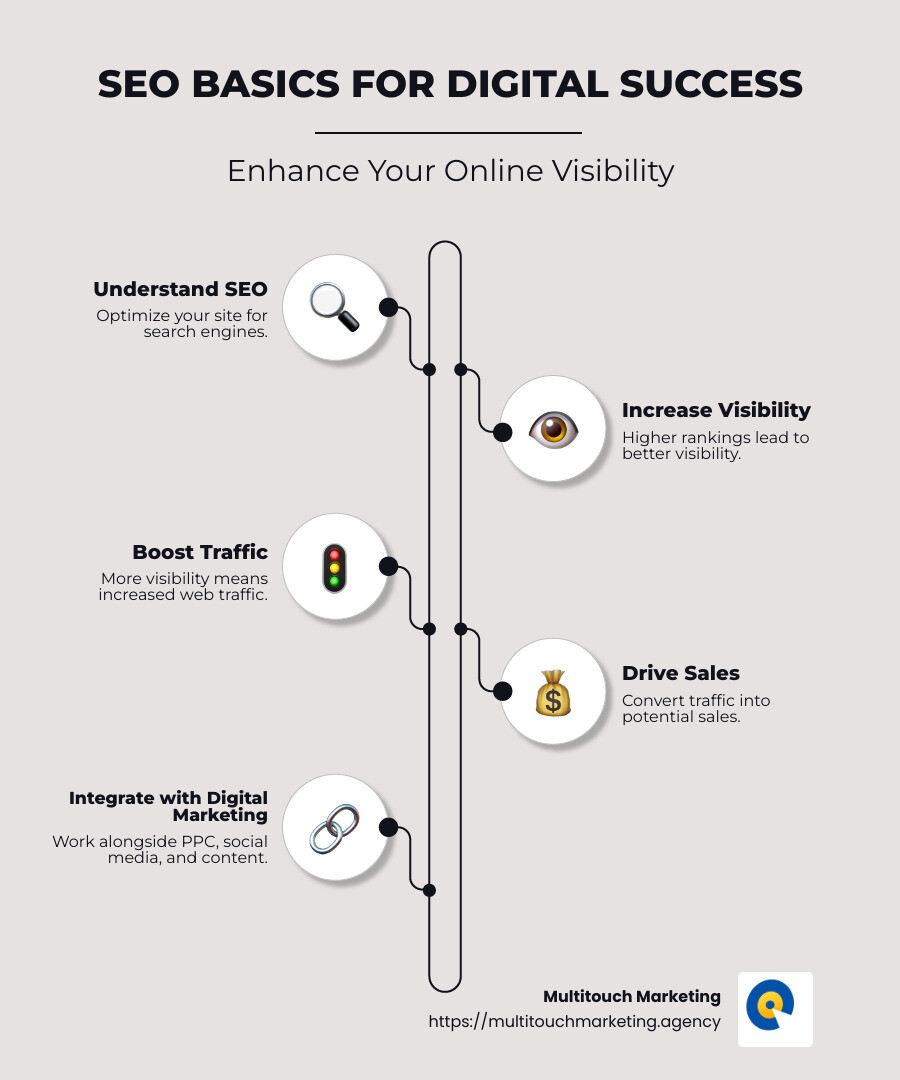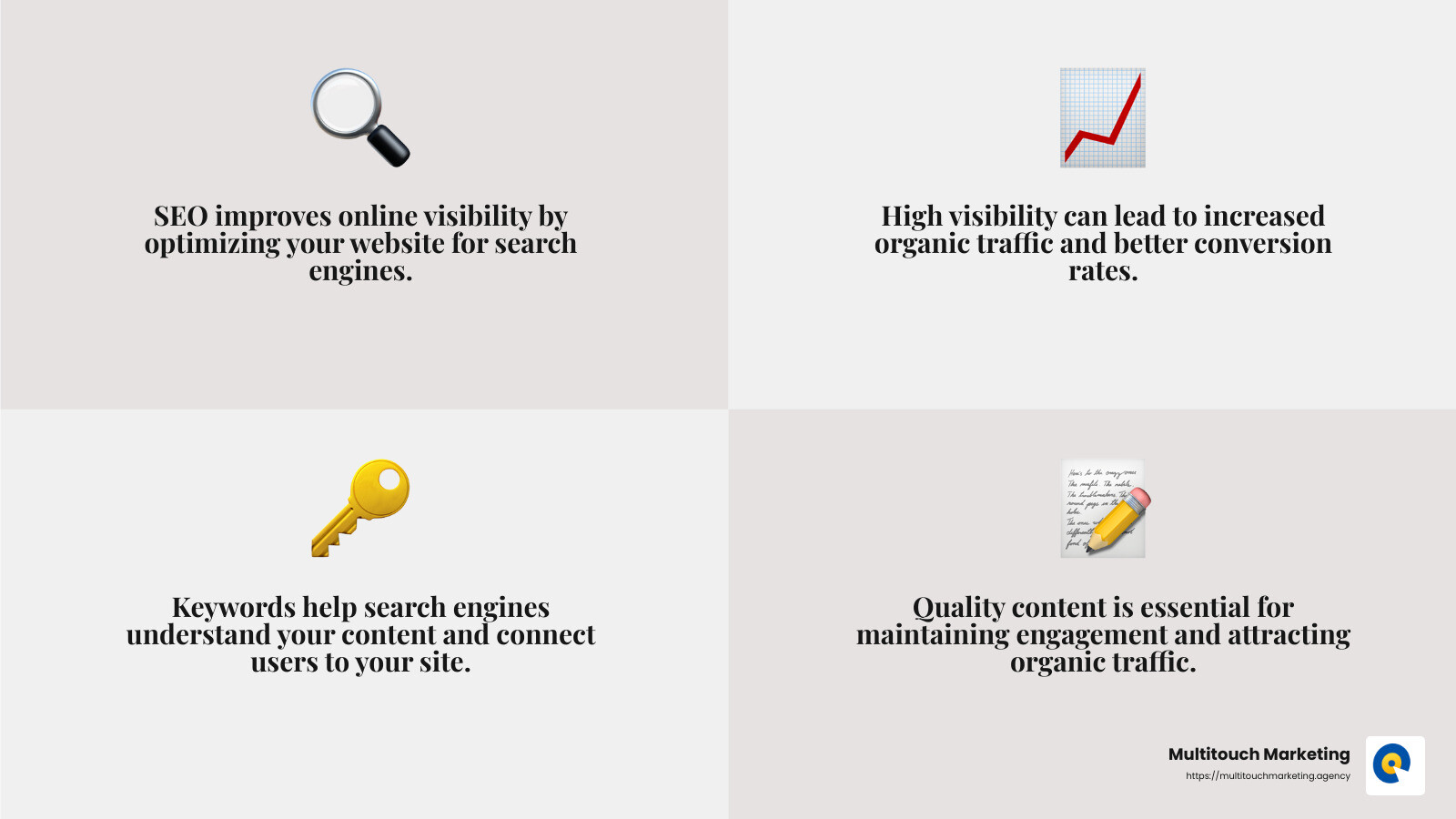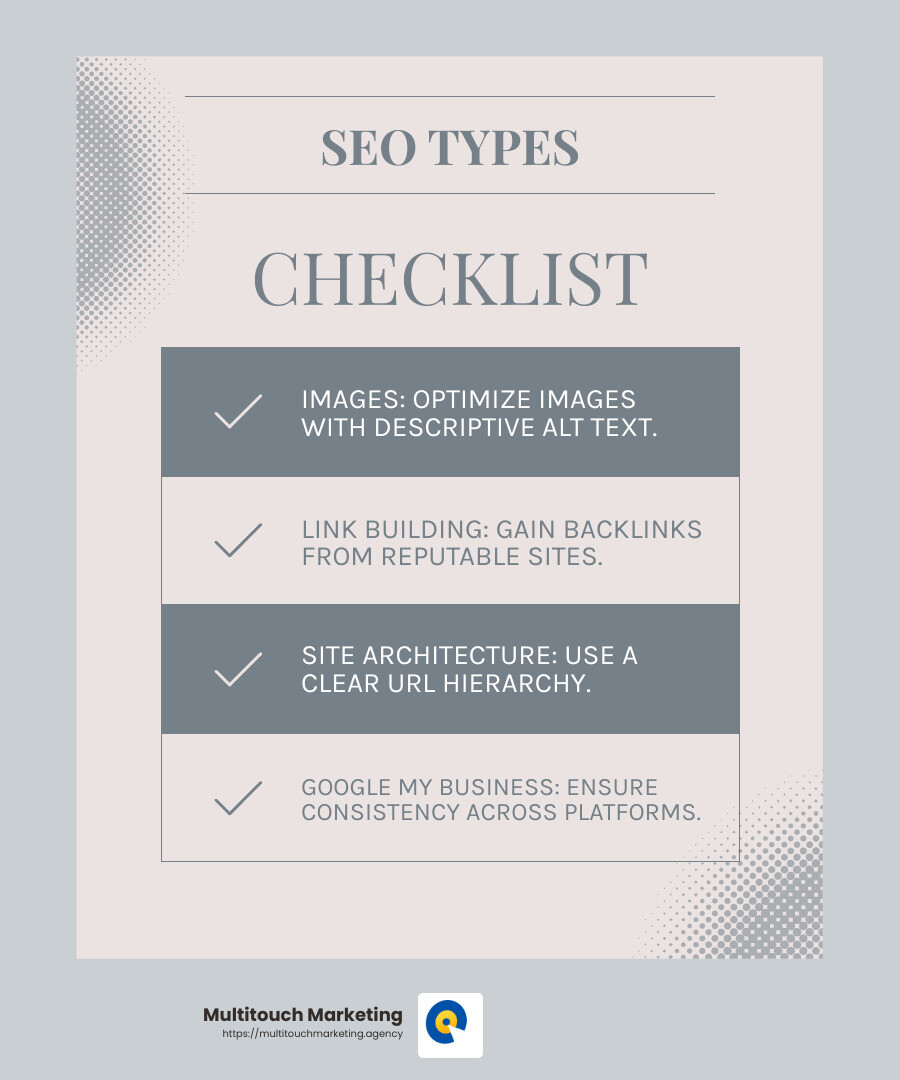Search Engine Optimization: 5 Proven Secrets in 2025
Search engine optimization (SEO) is a crucial tool for enhancing online visibility in today’s digital age. At its core, SEO involves strategies to improve your website’s ranking on search engines like Google. This makes it easier for customers to find your business online. Here are the basics to get you started:
- Understanding SEO: It’s about optimizing your website so search engines can easily understand and rank it.
- Why It Matters: Better SEO means higher visibility, leading to more traffic and potential sales.
- Its Role in Digital Marketing: SEO is a fundamental piece of digital marketing, working alongside PPC, social media, and content strategies.
I’m Milton Brown, and with my experience in search engine optimization, I help businesses harness data-driven strategies and AI innovations to boost their digital presence and online performance. Let’s dive deeper into how mastering SEO can transform your digital marketing efforts.

Understanding Search Engine Optimization
Search engine optimization (SEO) is the magic behind making your website more visible on the internet. Imagine your website as a hidden treasure; SEO is the map that guides people to it. When done right, SEO boosts your website’s visibility and attracts organic traffic—visitors who find your site through search engines without paid ads.
Visibility: The Key to Being Found
Think of visibility as being on the main street rather than a back alley. If your website is more visible, it means more people can find it when they search for related topics. High visibility on search engines like Google can significantly increase the number of visitors to your site.
- Organic Traffic: This is the unpaid traffic you get from search engines. It’s like having a steady stream of potential customers walk through your door without spending a dime on ads. Organic traffic is valuable because it often leads to higher conversion rates compared to paid traffic.
How SEO Boosts Visibility
SEO involves making your website appealing to search engines. This involves various techniques, such as:
- Using Keywords: Keywords are the terms people type into search engines. By strategically placing these words in your content, you help search engines understand what your page is about. For example, if you’re a bakery in Raleigh, using terms like “best cupcakes in Raleigh” can help attract local customers.
- Creating Quality Content: Search engines love fresh, relevant content. Regularly updating your site with blog posts, articles, or videos can keep it lively and engaging.
- Optimizing Metadata: Metadata, such as title tags and meta descriptions, provides a quick summary of your page’s content. Well-crafted metadata can improve click-through rates from search results.
The Role of SEO in Organic Traffic Growth
Organic traffic is not just about getting more visitors; it’s about getting the right visitors. These are people actively searching for what you offer. By focusing on search engine optimization, you can ensure your website appears in front of the right audience.
Real-Life Example: The Power of SEO
Consider a small bakery in Raleigh. By optimizing their website for local searches, they managed to increase their visibility online. They used keywords like “Raleigh bakery” and “fresh pastries Raleigh” in their content. As a result, their organic traffic doubled, leading to more foot traffic and sales.
In summary, understanding and applying SEO is essential for any business looking to improve its online presence. It’s about being found by the right people at the right time, without breaking the bank on advertising.
Next, we’ll explore the different types of SEO and how each plays a role in your digital marketing strategy.
Types of SEO
When it comes to search engine optimization, there are several types, each playing a crucial role in boosting your website’s visibility. Let’s explore the four main types: on-page SEO, off-page SEO, technical SEO, and local SEO.
On-Page SEO
On-page SEO is all about optimizing the content and elements on your website. Think of it as the art of making your pages appealing to both search engines and visitors.
- Content Optimization: Your content should be unique, engaging, and relevant to your audience. Use keywords naturally within your text, headings, and subheadings. This helps search engines understand the topic of your page.
- Metadata: Title tags and meta descriptions are vital. They act like a billboard for your content, enticing users to click on your link in search results. Keep them concise and include relevant keywords.
- Images: Don’t forget to optimize images by including descriptive alt text. This not only helps with SEO but also improves accessibility for visually impaired users.
Off-Page SEO
Off-page SEO focuses on activities outside your website that can affect your ranking.
- Link Building: This is about getting other reputable websites to link back to your site. Quality backlinks act as votes of confidence, signaling to search engines that your content is valuable and trustworthy.
- Social Signals: Although not a direct ranking factor, social media activity can indirectly boost your SEO. Sharing your content on social platforms increases its reach and potential for backlinks.
Technical SEO
Technical SEO ensures that your website is easy to crawl and index by search engines.
- Site Architecture: A well-structured website with a clear URL hierarchy helps search engines understand your content better. Use internal links to guide users and search engines through your site.
- Page Speed and Mobile-Friendliness: Fast-loading pages and mobile compatibility are crucial. Search engines prioritize sites that offer a seamless user experience, especially on mobile devices.
- Structured Data: Implement schema markup to help search engines understand the context of your content. This can improve your appearance in search results with rich snippets.
Local SEO
Local SEO is essential for businesses that want to attract customers in their geographical area.
- Google My Business: Claim and optimize your Google My Business listing. Ensure your business name, address, and phone number are consistent across all online platforms.
- Local Keywords: Use location-specific keywords in your content to target local customers. For instance, a bakery in Raleigh should use terms like “best bakery in Raleigh.”
- Customer Reviews: Encourage satisfied customers to leave positive reviews on platforms like Google and Yelp. Reviews can boost your local search visibility and credibility.
By understanding and implementing these types of search engine optimization, you can create a comprehensive strategy that improves your online presence. Each type plays a unique role in ensuring that your website is not only visible but also appealing to the right audience.
Next, we’ll explore how search engines work and how they determine which pages to show in search results.
How Search Engines Work
Search engines are like librarians for the internet. They help you find the information you need from the vast sea of online content. To do this, they use a process that involves crawling, indexing, and ranking.
Crawling
Imagine a team of robots, known as crawlers or spiders, tirelessly exploring the web. They start by visiting a webpage and then follow links on that page to find new pages. This process helps search engines gather fresh content and updates.
For instance, if a crawler visits a page about hiking boots on Patagonia.com, it will follow links to other related pages, like jackets or flannel shirts. This way, the crawler finds more content to add to its index.
Indexing
Once the crawlers gather information, it’s time for indexing. Think of indexing as organizing a library. Search engines take all the finded content and store it in a massive database called an index. This index is like a giant catalog, helping search engines quickly retrieve relevant pages when someone searches for information.
For example, when Google crawls a page about the negative impacts of fast fashion, it not only stores the content but also notes its relevance to other pages in the index. This helps Google provide more accurate search results.
Ranking
Now comes the important part—ranking. When you search for something, the search engine’s algorithm decides which pages to show first. It uses a complex formula to evaluate factors like content quality, relevance to the search query, and the website’s authority.
For instance, if you search for “best hiking boots,” Google will rank pages based on how well they match your query and how trustworthy they are. Pages with high-quality content, relevant keywords, and strong backlinks are more likely to appear at the top.
Algorithms
Algorithms are the secret sauce of search engines. They are complex mathematical formulas that determine how pages are ranked in search results. Google, for example, constantly updates its algorithm to provide the best user experience.
The algorithm considers hundreds of factors, such as:
- Content Quality: Is the content valuable and informative?
- Keywords: Does the page use keywords naturally?
- Backlinks: Are there reputable sites linking to the page?
- User Engagement: Do visitors find the page useful and stay longer?
By understanding these processes—crawling, indexing, ranking, and algorithms—you can better optimize your website for search engines. This knowledge is key to improving your site’s visibility and attracting more organic traffic.
Next, let’s dive into the best practices for SEO and how you can implement them to boost your site’s performance.
Best Practices for SEO
When it comes to search engine optimization, there are a few best practices that can significantly boost your website’s performance. These practices revolve around high-quality content, keywords, metadata, and link building.
High-Quality Content
Content is king! Search engines love content that is informative, engaging, and valuable to users. Here’s what you need to focus on:
- Relevance: Your content should address the needs and interests of your audience. Answer their questions and solve their problems.
- Depth: Go beyond the basics. Provide detailed information that adds value and keeps visitors engaged.
- Readability: Use simple language, short sentences, and clear headings to make your content easy to read. Break up long paragraphs and use bullet points or lists for better clarity.
Keywords
Keywords are the bridge between what people are searching for and the content you provide. Here’s how to use them effectively:
- Research: Start with a seed list of words and phrases that your audience is likely to search for. Use tools to find keywords with a good balance of search volume and competition.
- Placement: Integrate keywords naturally in your content. Place them in titles, headings, and throughout the body text without overstuffing.
- Long-Tail Keywords: These are longer and more specific keyword phrases. They often have lower competition and can attract more targeted traffic.
Metadata
Metadata helps search engines understand what your page is about. It includes elements like title tags and meta descriptions:
- Title Tags: Keep them concise (55-60 characters) and include your main keyword. They should be compelling enough to encourage clicks from search results.
- Meta Descriptions: Although not a direct ranking factor, a well-written meta description can improve click-through rates. Summarize the page content and include keywords naturally.
Link Building
Links are like votes of confidence from other websites. They tell search engines that your content is credible and valuable:
- Internal Links: Link to other relevant pages on your site to help users and search engines steer your content.
- External Links: Aim to get backlinks from reputable sites. This can be achieved by creating shareable content or collaborating with other websites.
- Avoid Low-Quality Links: Focus on quality over quantity. Links from spammy or irrelevant sites can harm your SEO efforts.
By focusing on these best practices—high-quality content, strategic keyword use, effective metadata, and robust link building—you can improve your website’s visibility and performance in search results.
Next, we’ll address some common questions about search engine optimization to help you get started on your SEO journey.
Frequently Asked Questions about Search Engine Optimization
What is Search Engine Optimization?
Search engine optimization (SEO) is the art of enhancing your website to increase its visibility on search engine results pages (SERPs). When people search for products or services related to your business, you want your site to appear high in the organic results. This is crucial because higher visibility often leads to more traffic, which can convert into customers.
Think of SEO as a way to make your website more “findable” by search engines like Google. It involves optimizing various elements of your website so that search engines can easily understand and rank your content.
How to do SEO for beginners?
Starting with SEO can feel overwhelming, but here are some simple steps to get you on your way:
- Content Findy: Begin by identifying what your audience is searching for. Create content that answers their questions or solves their problems. Make sure it’s high-quality and relevant.
- Descriptive URLs: Use clear and descriptive URLs for your pages. For example, instead of “www.example.com/page1,” use “www.example.com/organic-coffee-benefits.” This helps both users and search engines understand what the page is about.
- Link Building: Start with internal links by connecting related pages within your site. This helps search engines and visitors steer your content. As you grow, aim to earn backlinks from reputable external sites. This can boost your credibility and authority in the eyes of search engines.
Can I do SEO on my own?
Absolutely! Many small business owners start with DIY SEO. With some dedication and the right tools, you can make significant improvements to your website’s visibility. Here are a few tools to help you get started:
- Google Analytics: Track your website traffic and understand user behavior.
- Google Search Console: Monitor your site’s performance in Google Search and fix issues.
- Keyword Research Tools: Find what your audience is searching for and identify opportunities to rank for those terms.
However, as your business grows, you might consider seeking professional help. SEO experts can offer advanced strategies and insights to take your efforts to the next level. They can also save you time and ensure that your SEO strategy aligns with your business goals.
In the next section, we’ll explore more about how search engines work and the role algorithms play in determining your website’s ranking.
Need Help?
As we’ve explored, search engine optimization (SEO) is a vital tool in building a strong digital presence. It’s not just about getting your website to rank higher; it’s about making your business more visible to the people who are searching for what you offer. By implementing a solid SEO strategy, you can connect with your audience more effectively and drive more organic traffic to your site.
At Multitouch Marketing, we understand the complexities of SEO and how it fits into the broader landscape of digital marketing. Our team specializes in crafting custom SEO strategies that align with your business goals. Whether you’re a small business owner just starting or a larger enterprise looking to refine your approach, we can provide the expertise and support you need to succeed.
Our services extend beyond just SEO. With our focus on pay-per-click (PPC) advertising, we offer a comprehensive digital marketing solution that can improve your online presence and drive results. By working with us, you gain access to a team that is dedicated to helping you steer the ever-changing world of digital marketing.
Ready to boost your web ranking and improve your digital presence? Contact us today to learn more about how our SEO and digital marketing services can benefit your business.
In conclusion, SEO is not a one-time effort but an ongoing process that requires attention and adaptation. By staying informed and working with experts, you can ensure that your website remains competitive and continues to attract the right audience. Thank you for joining us on this journey to open uping the secrets of SEO!



